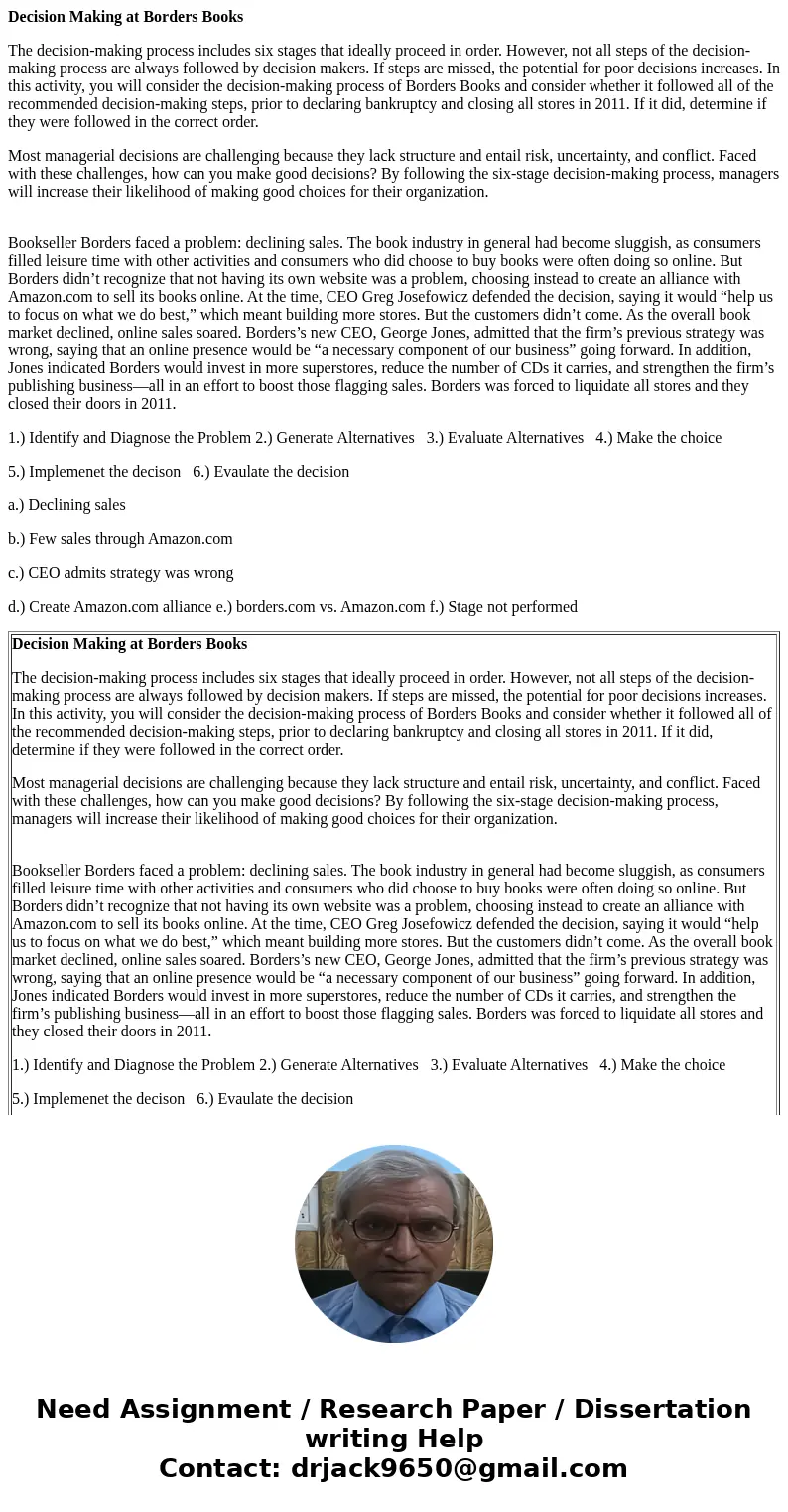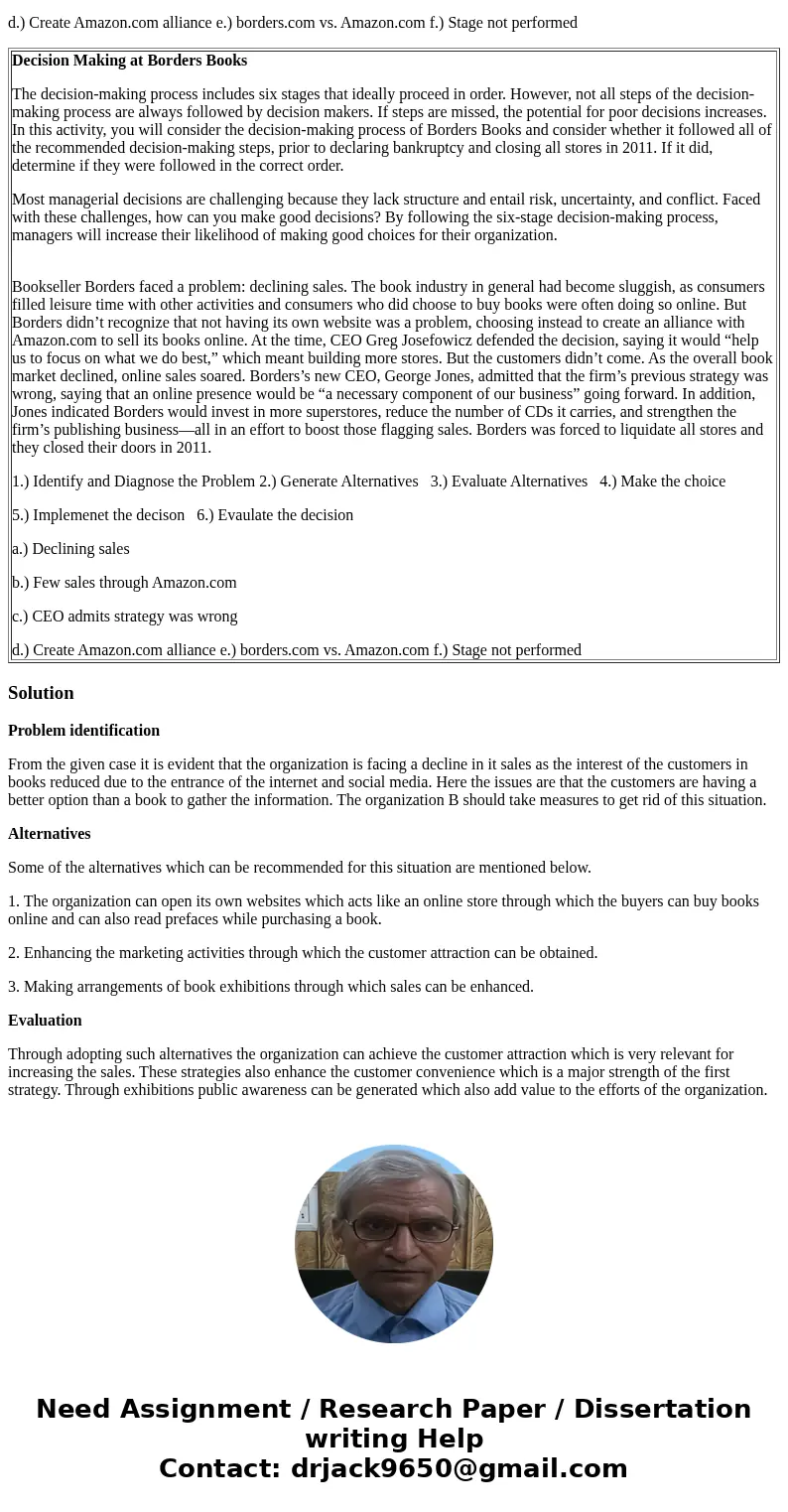Decision Making at Borders Books The decisionmaking process
Decision Making at Borders Books
The decision-making process includes six stages that ideally proceed in order. However, not all steps of the decision-making process are always followed by decision makers. If steps are missed, the potential for poor decisions increases. In this activity, you will consider the decision-making process of Borders Books and consider whether it followed all of the recommended decision-making steps, prior to declaring bankruptcy and closing all stores in 2011. If it did, determine if they were followed in the correct order.
Most managerial decisions are challenging because they lack structure and entail risk, uncertainty, and conflict. Faced with these challenges, how can you make good decisions? By following the six-stage decision-making process, managers will increase their likelihood of making good choices for their organization.
Bookseller Borders faced a problem: declining sales. The book industry in general had become sluggish, as consumers filled leisure time with other activities and consumers who did choose to buy books were often doing so online. But Borders didn’t recognize that not having its own website was a problem, choosing instead to create an alliance with Amazon.com to sell its books online. At the time, CEO Greg Josefowicz defended the decision, saying it would “help us to focus on what we do best,” which meant building more stores. But the customers didn’t come. As the overall book market declined, online sales soared. Borders’s new CEO, George Jones, admitted that the firm’s previous strategy was wrong, saying that an online presence would be “a necessary component of our business” going forward. In addition, Jones indicated Borders would invest in more superstores, reduce the number of CDs it carries, and strengthen the firm’s publishing business—all in an effort to boost those flagging sales. Borders was forced to liquidate all stores and they closed their doors in 2011.
1.) Identify and Diagnose the Problem 2.) Generate Alternatives 3.) Evaluate Alternatives 4.) Make the choice
5.) Implemenet the decison 6.) Evaulate the decision
a.) Declining sales
b.) Few sales through Amazon.com
c.) CEO admits strategy was wrong
d.) Create Amazon.com alliance e.) borders.com vs. Amazon.com f.) Stage not performed
| Decision Making at Borders Books The decision-making process includes six stages that ideally proceed in order. However, not all steps of the decision-making process are always followed by decision makers. If steps are missed, the potential for poor decisions increases. In this activity, you will consider the decision-making process of Borders Books and consider whether it followed all of the recommended decision-making steps, prior to declaring bankruptcy and closing all stores in 2011. If it did, determine if they were followed in the correct order. Most managerial decisions are challenging because they lack structure and entail risk, uncertainty, and conflict. Faced with these challenges, how can you make good decisions? By following the six-stage decision-making process, managers will increase their likelihood of making good choices for their organization.
1.) Identify and Diagnose the Problem 2.) Generate Alternatives 3.) Evaluate Alternatives 4.) Make the choice 5.) Implemenet the decison 6.) Evaulate the decision a.) Declining sales b.) Few sales through Amazon.com c.) CEO admits strategy was wrong d.) Create Amazon.com alliance e.) borders.com vs. Amazon.com f.) Stage not performed |
Solution
Problem identification
From the given case it is evident that the organization is facing a decline in it sales as the interest of the customers in books reduced due to the entrance of the internet and social media. Here the issues are that the customers are having a better option than a book to gather the information. The organization B should take measures to get rid of this situation.
Alternatives
Some of the alternatives which can be recommended for this situation are mentioned below.
1. The organization can open its own websites which acts like an online store through which the buyers can buy books online and can also read prefaces while purchasing a book.
2. Enhancing the marketing activities through which the customer attraction can be obtained.
3. Making arrangements of book exhibitions through which sales can be enhanced.
Evaluation
Through adopting such alternatives the organization can achieve the customer attraction which is very relevant for increasing the sales. These strategies also enhance the customer convenience which is a major strength of the first strategy. Through exhibitions public awareness can be generated which also add value to the efforts of the organization.


 Homework Sourse
Homework Sourse